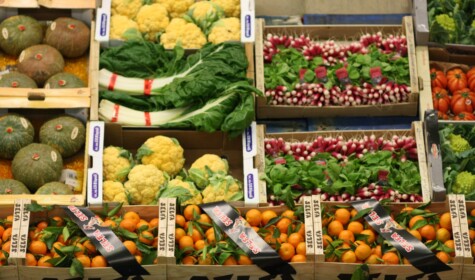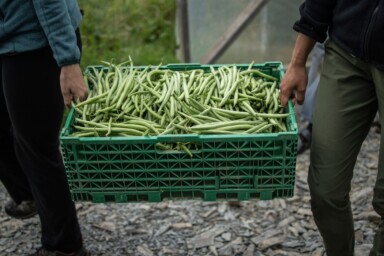What is ‘local’ food? It’s a term we’re all familiar with and something we think we’d be quite confident at explaining – until we try. From definitions based on geographical distance to defining local in terms of things like environmental performance and social value, or suggestions that local should mean what consumers think it means, this apparently common sense term has evaded being pinned down. That matters, because to work out how to nurture these systems, people need to know what is to be nurtured.
And this brings us to a second issue – should we nurture these systems? Does local food really deliver more benefits than the globalised food supply system most of us buy the majority of our food from?
In environmental terms, the answer is ‘not necessarily’ – at least according to much of the academic research carried out to date. The simplest idea – that reducing food miles must reduce the carbon footprint of our food – has long been questioned, with the prevailing view that the most food-related emissions come from its production, not its transport. However, more recent work estimates that food miles might make up almost 20% of global food related emissions, demonstrating that as research methods improve and the availability of data increases, our understanding of the impacts of local and global food systems can change dramatically.
There is, of course, more to environmental impacts than the effects of greenhouse gas emissions. But the consensus is that the kinds of food we eat and how they are produced are more important than whether a supply chain is local or global in terms of reducing negative environmental impacts like biodiversity loss.
Turning to social benefits, the positives are easier to find – for example, local food systems often bring greater rewards for producers and can support local economies through jobs in local agri-business, as well as having an important role in promoting tourism. Local people involved in their food supply chains, from community supported agriculture to growing schemes and community-run retail outlets, benefit from closer social bonds and a positive sense of place. Those who visit farmers markets or other direct selling points get to talk to producers and understand more about their food and the people who produce it, and farmers get the satisfaction of sharing information about the value of their products and the care and effort that has gone into their production. Trust, engagement and social motives replace the narrow transactional model of the mainstream, where quality is communicated and assured by labels and the connection between producer and consumer is at best tenuous.
On the other hand, local food supply systems do not necessarily make good quality food more accessible to less well-off local people. The value-added benefits of local marketing arise at least in part from being able to sell local products at a premium. In turn, this means that local food suppliers may benefit most if they can market their local brand beyond their geographic region, to wherever there are people able to pay extra for food with a local story and a promise of high quality.
This paints a rather negative picture – we can’t really define what local food is, and when it’s evaluated using the normal definitions, it isn’t always guaranteed to be any better for society as a whole than the globalised food system – despite the potential for local benefits to producers or those engaged with local supply systems. And yet local food persists, thriving in many places, and appears to make those involved with it happier and more fulfilled.
The contradictions between the rich benefits demonstrated by specific examples of local food systems and the academic research evidence about local food in general, suggest that we might be approaching the question of local food in the wrong way.
Firstly, the mixed evidence for the advantages of local over global food, comes from an evolving research field. New approaches and new focuses for research are being identified and explored all the time, and they can lead to big changes in our understanding, as the example of the debate on emissions from food miles shows.
A particular problem to date has been the focus in many studies (for practical reasons) on narrow definitions of local food, with findings then used by others as evidence for or against local food systems in general. In other cases, many types of local food systems may be lumped together and compared with global food systems. Doing so ignores the differing motives, drivers, approaches and characteristics of local food systems. Differences in the effects these diverse systems have, may mean that their benefits and costs cancel each other out when they are viewed as one group. An example is food access – while many community-focused growing schemes most certainly increase access to high quality, healthy food for local people, more market-driven local food supply systems may supply produce at higher prices, reducing accessibility. Merging the two types of systems together hides the differing impacts of each. Research into the pros and cons of local versus globalised food supply chains needs to recognise, characterise and distinguish between these diverse local systems if they are to be meaningfully valued.
Secondly, local food systems may not always out-perform globalised supply systems in all respects – but to expect any system to be ‘best’ in every way is entirely unrealistic. Instead, we need to admit the problems of the current system and work to resolve them, while at the same time exploring and maximising the benefits of the local alternatives. When these alternatives enhance the well-being of communities and address some of the failings of the globalised food supply system, positive interventions need to be made to carve out space for them. This is because the existing market, infrastructure, planned environment and rules of the game are often stacked against them. Our food systems should work for us, and be shaped by our needs, irrespective of our financial status or level of influence.
Connecting with others in local food systems, sharing ideas and perspectives and accessing communal spaces for these connections to grow, creates the kind of environment in which a desire to be more sustainable, to improve access to high quality food for everyone and for producers to get a fairer deal, can spur those involved in local food to make it a better option, even if ‘localness’ in itself might not automatically bring improvements. Tensions, like those between the need for fairer prices for producers and the need for wider access to good quality food for communities, are real. However, approaches to food which are based on trust, human connection, pride in community and in mutual care rather than charity, are those most likely to provide resilient solutions to these challenges.
The Sustainable Food Trust is working in collaboration with the Landworkers Alliance, Sustain, the Food, Farming and Countryside Commission and Pasture for Life to bring together a more holistic, multi-faceted vision of local food and an action plan for its support and growth. Along with a wide and rich diversity of other initiatives and projects in this field, the partnership contributes to efforts to maximise the environmental and social benefits provided by thriving communities centred on local food.







